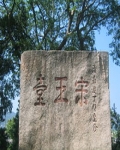Sung Wong Toi
Archaeology »
Archaeological Monuments » Sung Wong Toi
Sung Wong Toi -
Sung Wong Toi is located in Kowloon..
Sung Wong Toi monument was established on 1277 between 1279.
Primary threats to Sung Wong Toi :
The name Sung Wong Toi literally means Terrace of the Sung kings. The stone is believed to have been a memorial to the last two boy emperors of the Southern Song Dynasty, Zhao Shi and Zhao Bing, who temporarily lived in Hong Kong from 1277 to 1279.
Historical facts of Sung Wong Toi :
- Introduction :
The Sung Wong Toi monument, established between 1277 and 1279, stands as an important historical relic from ancient Chinese history. Located in Kowloon, Hong Kong, this stone monument holds intriguing historical facts that shed light on the significant events and figures of the era. In this essay, we will explore the origins, historical context, and the enduring legacy of the Sung Wong Toi monument.
- Origins and Purpose :
The Sung Wong Toi monument, which translates to "Terrace for the King of Sung," was erected during the Southern Song Dynasty (1127-1279) to commemorate the brief yet eventful reign of the last Southern Song Emperor, Zhao Bing. The construction of the monument took place between 1277 and 1279 AD, and it was situated at the banks of the Shing Mun River in Kowloon, facing the vast expanse of Victoria Harbor.
- The Reign of Emperor Zhao Bing :
Emperor Zhao Bing ascended the throne at a young age, following the tragic death of his father, the Song Emperor Duanzong, during the fall of the Song Dynasty's capital, Hangzhou, to the invading Mongol forces led by Kublai Khan. As the Mongol forces pressed southward, the young emperor, along with his loyal subjects, sought refuge in the southern territories, where he briefly ruled from Kowloon before his ultimate capture by the Mongols.
- A Symbol of Resilience and Defiance :
The Sung Wong Toi monument stands as a symbol of defiance and resilience against the Mongol invasion. It represents the determination of the Southern Song Dynasty to preserve their identity and culture despite facing overwhelming odds. The inscription on the monument narrates the emperor's gallant resistance and his determination to defend his kingdom against the Mongol invaders.
- The Stone Inscriptions :
The monument features stone inscriptions with Chinese calligraphy, providing historical details about Emperor Zhao Bing and the events surrounding the fall of the Southern Song Dynasty. The inscriptions describe the emperor's bravery, the loyalty of his subjects, and the devastating impact of the Mongol conquest. These inscriptions are valuable historical records that offer insight into the turbulent times of the Southern Song Dynasty.
- Relocation and Renovation :
Over the centuries, the Sung Wong Toi monument underwent several relocations and renovations. Due to urban development, it was moved several times within Kowloon. The most recent relocation took place in 1937 when it was moved to its current location in Kowloon Walled City Park, where it now stands as a protected heritage site.
- Kowloon Walled City Park :
The monument's current location within the Kowloon Walled City Park adds to its historical significance. The park itself was once the site of the Kowloon Walled City, a densely populated and unregulated urban settlement that stood for decades. Preserving the Sung Wong Toi monument within this park ensures that its historical context is honored and appreciated by visitors.
- Cultural Heritage and Tourism :
The Sung Wong Toi monument has become an essential cultural and historical attraction for both locals and tourists. Its historical significance, coupled with its picturesque location in the Kowloon Walled City Park, draws visitors who seek to explore ancient Chinese history and appreciate the architectural beauty of the monument.
- Conclusion :
The Sung Wong Toi monument, established between 1277 and 1279, is a precious relic that offers a glimpse into the tumultuous era of the Southern Song Dynasty in ancient Chinese history. This stone monument stands as a symbol of resilience, defiance, and the determination of Emperor Zhao Bing and his loyal subjects to protect their kingdom against the Mongol invaders. Preserved within the Kowloon Walled City Park, the monument continues to be a cherished cultural heritage site, inviting visitors to connect with the historical past and appreciate the enduring legacy of ancient China.

